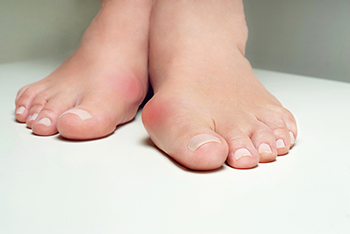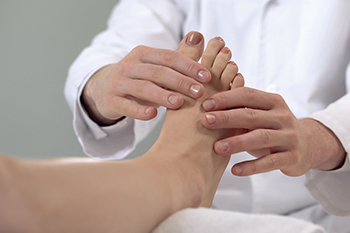Freehold (732) 294-9393
Freehold (732) 294-9393

Common ways an ankle can be broken include twisting the ankle beyond its limit or enduring a foot injury. There are noticeable symptoms that accompany a broken ankle. Many people are unable to walk with this type of injury, and there is often immediate pain felt and bruising. In severe breaks, a bone may become displaced where it can look deformed. If a broken ankle is suspected, a proper diagnosis is needed. Generally, this includes having an X-ray taken. Treatment can begin with placing the affected foot in a protective cast or boot, which is a successful method that helps the patient keep weight off the foot. A broken ankle can take up to approximately 12 weeks to completely heal, at which time full range of motion is often restored. A displaced ankle bone may require surgery that can help to put the bone back into its normal position and with this, a longer recovery time may be needed. If you have fractured your ankle, it is advised that you consult a podiatrist who can guide you toward the treatment that is best for you.
Broken ankles need immediate treatment. If you are seeking treatment, contact Dr. Henry Miller from New Jersey. Our doctor can provide the care you need to keep you pain-free and on your feet.
Broken Ankles
A broken ankle is experienced when a person fractures their tibia or fibula in the lower leg and ankle area. Both of these bones are attached at the bottom of the leg and combine to form what we know to be our ankle.
When a physician is referring to a break of the ankle, he or she is usually referring to a break in the area where the tibia and fibula are joined to create our ankle joint. Ankles are more prone to fractures because the ankle is an area that suffers a lot of pressure and stress. There are some obvious signs when a person experiences a fractured ankle, and the following symptoms may be present.
Symptoms of a Fractured Ankle
If you suspect an ankle fracture, it is recommended to seek treatment as soon as possible. The sooner you have your podiatrist diagnose the fracture, the quicker you’ll be on the way towards recovery.
If you have any questions, please feel free to contact our office located in Freehold, NJ . We offer the newest diagnostic and treatment technologies for all your foot care needs.

A bunion is one of the more noticeable foot conditions. The bony protrusion that forms on the side of the big toe is a clear indication that a bunion is developing. It happens as a result of genetics, or from wearing shoes that do not have adequate room for the toes to move freely in. Additionally, a bunion can develop from a foot injury, or from having poor foot structure. It can cause a misalignment in the other toes, and they may shift toward each other. The pain from a bunion may become worse when pressure is exerted on it, such as from running or walking, and it is best if minimal walking is done to help provide mild relief. Maintaining a healthy weight may help to reduce pain from a bunion, in addition to wearing a protective covering over it while wearing shoes. Bunions can be unsightly and uncomfortable, and if you are afflicted with one, it is strongly advised that you confer with a podiatrist who can guide you toward the correct treatment techniques. Surgery may be performed for permanent removal.
If you are suffering from bunions, contact Dr. Henry Miller of New Jersey. Our doctor can provide the care you need to keep you pain-free and on your feet.
What Is a Bunion?
A bunion is formed of swollen tissue or an enlargement of boney growth, usually located at the base joint of the toe that connects to the foot. The swelling occurs due to the bones in the big toe shifting inward, which impacts the other toes of the foot. This causes the area around the base of the big toe to become inflamed and painful.
Why Do Bunions Form?
Genetics – Susceptibility to bunions are often hereditary
Stress on the feet – Poorly fitted and uncomfortable footwear that places stress on feet, such as heels, can worsen existing bunions
How Are Bunions Diagnosed?
Doctors often perform two tests – blood tests and x-rays – when trying to diagnose bunions, especially in the early stages of development. Blood tests help determine if the foot pain is being caused by something else, such as arthritis, while x-rays provide a clear picture of your bone structure to your doctor.
How Are Bunions Treated?
If you have any questions, please feel free to contact our office located in Freehold, NJ . We offer the newest diagnostic and treatment technologies for all your foot care needs.

If your child participates in sporting activities and complains of heel pain, it may be indicative of Sever’s disease. The heel plate becomes inflamed which may occur due to high-impact activities. Swelling and pain often accompany Sever’s disease, and it can develop in children and young teenagers. Children who develop this ailment may be affected psychologically. This may be noticeable if the child declines participation in specific activities because of chronic heel pain. Additionally, their athletic ability may suffer a setback in their chosen sport as a result of being omitted from participation. Sever’s disease is treated by stopping the activity that caused the pain, followed by performing specific stretches that can help to provide mild relief. If your child has heel pain, it is strongly urged that you contact a podiatrist who can effectively diagnose Sever’s disease and offer extended treatment options.
Sever's disease often occurs in children and teens. If your child is experiencing foot or ankle pain, see Dr. Henry Miller from New Jersey. Our doctor can treat your child’s foot and ankle needs.
Sever’s Disease
Sever’s disease is also known as calcaneal apophysitis, which is a medical condition that causes heel pain I none or both feet. The disease is known to affect children between the ages of 8 and 14.
Sever’s disease occurs when part of the child’s heel known as the growth plate (calcaneal epiphysis) is attached to the Achilles tendon. This area can suffer injury when the muscles and tendons of the growing foot do not keep pace with bone growth. Therefore, the constant pain which one experiences at the back of the heel will make the child unable to put any weight on the heel. The child is then forced to walk on their toes.
Symptoms
Acute pain – Pain associated with Sever’s disease is usually felt in the heel when the child engages in physical activity such as walking, jumping and or running.
Highly active – Children who are very active are among the most susceptible in experiencing Sever’s disease, because of the stress and tension placed on their feet.
If you have any questions, please feel free to contact our office located in Freehold, NJ . We offer the newest diagnostic and treatment technologies for all your foot and ankle injuries.

Many people who fall are reluctant to speak to their doctors about it. Research has shown that falling affects approximately 25% of the population and is the number one cause of injuries in people who are over 65 years of age. There are various foot injuries that can occur as a result of falling, including a broken toe, ankle, or foot. This can wreak havoc on completing daily activities, and it is beneficial when prevention methods are implemented. These can consist of removing clutter and worn rugs, improving lighting in the household, and it may help to avoid wearing pants that are too long. Additionally, many people install grab bars in the shower and toilet area, and using a bath mat may help to eliminate or reduce slipping accidents. Many older people choose to live on one floor, thus avoiding falling down the steps. If you would like more information about the importance of how to prevent falling, and simple methods that can allow that, please confer with a podiatrist.
Preventing falls among the elderly is very important. If you are older and have fallen or fear that you are prone to falling, consult with Dr. Henry Miller from New Jersey. Our doctor will assess your condition and provide you with quality advice and care.
Every 11 seconds, an elderly American is being treated in an emergency room for a fall related injury. Falls are the leading cause of head and hip injuries for those 65 and older. Due to decreases in strength, balance, senses, and lack of awareness, elderly persons are very susceptible to falling. Thankfully, there are a number of things older persons can do to prevent falls.
How to Prevent Falls
Some effective methods that older persons can do to prevent falls include:
Falling can be a traumatic and embarrassing experience for elderly persons; this can make them less willing to leave the house, and less willing to talk to someone about their fears of falling. Doing such things, however, will increase the likelihood of tripping or losing one’s balance. Knowing the causes of falling and how to prevent them is the best way to mitigate the risk of serious injury.
If you have any questions, please feel free to contact our office located in Freehold, NJ . We offer the newest diagnostic and treatment technologies for all your foot care needs.